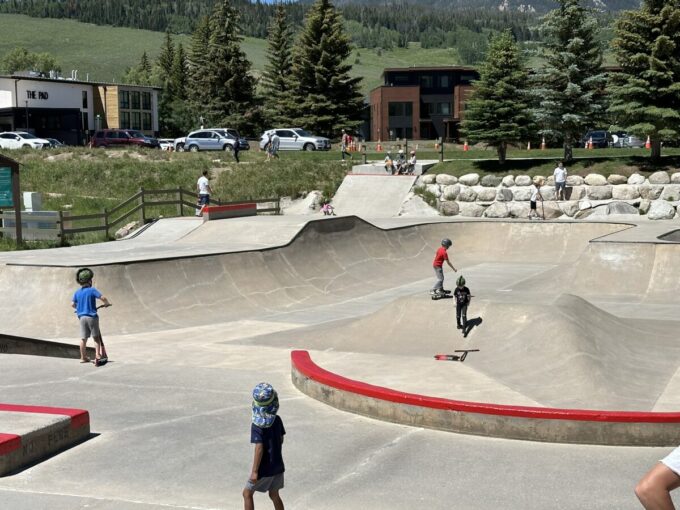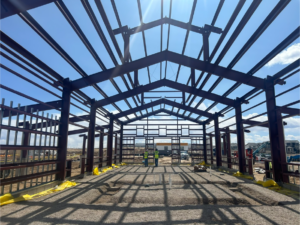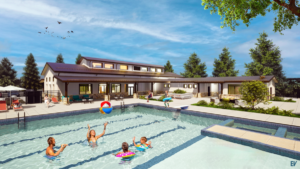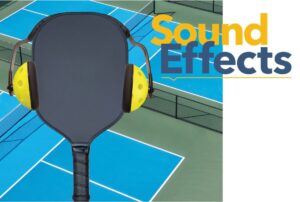Trends in Skate Park Design
Skate parks have evolved from simple concrete slabs to complex environments catering to diverse user groups. Modern skate parks incorporate features that appeal to skateboarders, BMX riders, and scooter enthusiasts, making them versatile recreational spaces. This article explores the different types of skate parks, design considerations for public recreation settings, user group overlap, optimal park sizes, perimeter safety areas, and surfacing recommendations.

Types of Skate Parks
Skate parks come in various forms, each catering to specific riding styles and skill levels:
- Street Plaza: Mimicking urban environments, street plazas feature elements like stairs, rails, ledges, and benches. As a result, these parks attract skateboarders and BMX riders who enjoy street-style tricks.
- Flow Park: Flow parks combine transition and street elements, offering a mix of ramps, bowls, and street features. Consequently, this design provides versatility, catering to different riding styles and skill levels.
- Bowl or Transition Park: These parks focus on smooth, curved surfaces like bowls, half-pipes, and vert ramps. Bowl parks are ideal for skaters and BMX riders who prefer transition-style riding.
- Hybrid Park: Combining elements of street, flow, and bowl parks, hybrid parks provide a diverse experience. Therefore, they accommodate a wide range of users and offer something for everyone.
Incorporating Versatile Features
To create a versatile skate park for a public setting, designers must consider incorporating various features:
- Multi-Level Sections: Designing different elevation levels allows for varied difficulty and skill progression, making the park accessible to beginners and challenging for advanced users.
- Modular Elements: Including modular or interchangeable features allows the park to evolve over time, adapting to changing trends and user preferences.
- Mixed Terrain: Combining street, transition, and flow elements within one park creates a multi-functional space that attracts a broader user base.
- Green Space Integration: Integrating skate parks into green spaces enhances the park’s aesthetic and provides areas for rest and observation, making it more inviting for the community.
User Groups and Sport Overlap
Modern skate parks cater to multiple user groups, including skateboarders, BMX riders, scooter riders, and inline skaters. Understanding how these sports overlap is crucial for effective design:
- Skateboarders: Skateboarders prefer street features like rails and ledges, as well as transition elements like bowls.
- BMX Riders: BMX riders favor larger transitions, including ramps, bowls, and dirt jumps, but also enjoy street features.
- Scooter Riders: Scooter riders use a mix of street and transition elements, often gravitating toward smaller ramps and ledges.
- Inline Skaters: Inline skaters thrive in environments with smooth transitions, bowls, and half-pipes, but also use street features.
Optimal Skate Park Size and Perimeter Area
The size of a skate park depends on the expected user volume and the variety of features included:
- Small Community Parks: For smaller communities, a skate park of around 5,000 to 10,000 square feet can accommodate basic features and cater to beginners and intermediate users.
- Mid-Sized Parks: A park of 10,000 to 20,000 square feet provides space for more diverse features, supporting a broader range of skill levels and multiple user groups.
- Large Regional Parks: Regional skate parks, ranging from 20,000 to 40,000 square feet or more, can host competitions and cater to advanced users. These parks often include all three skate park types and accommodate a high user volume.
- Perimeter Area for Access and Safety: Surrounding the park with at least 10 to 20 feet of open space ensures safety and provides areas for spectators and easy access. Buffer zones also help reduce the risk of collisions and allow for safe entry and exit points.
Skate Park Surfacing Recommendations
Choosing the right surfacing material is critical for skate park durability and user experience:
- Concrete: Concrete is the most popular skate park surface due to its durability, smooth finish, and low maintenance. It allows for precise construction of complex features and provides a consistent riding surface.
- Asphalt: While less common, asphalt can be used for budget-conscious projects. However, it requires more maintenance and may crack over time, affecting the quality of the riding surface.
- Prefabricated Materials: Modular steel or polymer ramps offer a cost-effective solution, especially for smaller parks or temporary installations. These materials are easy to install and replace, but they may not offer the same ride quality as concrete.
- Maintenance Considerations: To ensure low maintenance, designers should choose high-quality concrete and apply protective sealants. Regular inspections and prompt repairs of cracks or surface damage can prolong the park’s lifespan and maintain safety standards.
Conclusion
In conclusion, modern skate park design trends focus on creating versatile, multi-functional spaces that cater to diverse user groups. By incorporating a mix of street, flow, and bowl elements, and considering the needs of skateboarders, BMX riders, scooter riders, and inline skaters, designers can create parks that serve entire communities. Optimal park sizing, adequate perimeter space, and durable surfacing are key to ensuring the longevity and success of these recreational spaces. By adhering to these design principles, communities can create skate parks that not only meet the needs of current users but also adapt to future trends.
References
- American Society of Landscape Architects (ASLA). (2023). Skate Park Design Guidelines. Retrieved from ASLA
- Skatepark Association of the United States of America (SPAUSA). (2023). Skatepark Construction and Design Standards. Retrieved from SPAUSA
- Public Skatepark Development Guide. (2022). Planning and Building Successful Skateparks. Retrieved from Public Skatepark Development










